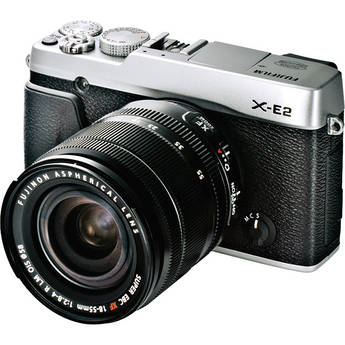
Fujifilm X-E2 Mirrorless Digital Camera with 18-55mm Lens (Silver)
If you’ve followed my blog then you know I’m a big fan of Fujifilm X-Series cameras, so I’ve been eager to get my hands on the X-E2. There was always something about the X-E1, X-Pro1, and x100s that gave me a good excuse for not owning them, but on paper this looked to be THE Fujifilm that seemed worth of my hard earned cash.
Want to know if it got it? Stay tuned for part II of my review of this camera.
Sample Photos
You can view the full set of casual snapshot photos at http://photos.ronmartblog.com/fujifilm/x-e2. Please note that this gallery currently contains images that were shot with the internal noise reduction feature set to –2 (basically, off). This will cause pixel peepers to incorrectly assume that the X-E1 had better noise handling but that couldn’t be farther from the truth. In fact, I set the camera to –2 for my testing specifically so I could see how much it has improved.
The film mode choice was Velvia which won’t be to everyone’s taste, but I like it enough that I typically don’t do editing on X-Series images shot in Velvia. That’s exactly what I want from a little camera, so it’s one of the many reasons I like this platform.
Please note that all of these images are the original jpeg’s as they came out of the camera. If you click the image you’ll see the full size version exactly as it came out of the camera. The file name will also offer a clue as to what’s what lens and settings were used when the shot was taken.

Typical Fuji good job with backlighting
f/4 @ 18 mm, 1/60, ISO 2000, No Flash

I love the colors out of camera
f/2.8 @ 18 mm, 1/60, ISO 250, No Flash

The “kit” lens is still plenty nice in my opinion
f/3.2 @ 21.4 mm, 1/40, ISO 6400, No Flash

This is where not having a low pass filter pays off!
X-E2, f/16 @ 19.6 mm, 12s, ISO 200, No Flash

This camera is going to be fun with winter skies!
f/3.2 @ 18 mm, 1/150, ISO 800, No Flash
Lightroom 5.3 & Adobe Camera Raw 8.3
On December 11th Adobe released Lightroom 5.3 and Adobe Camera Raw 8.3 to allow support of RAW files in their products. I’ve checked it out and it works great. The raw processing is Adobe standard so it doesn’t simulate the film simulation modes (i.e., Velvia as shown in my images) but it is on par with the raw processing I see with Adobe standard on Canon and Nikon cameras. The default film mode on Fujifilm is Provia which is still more saturated than Adobe Standard RAW processing, but the effect can easily be simulated by dragging the saturation slider. This is on par with the latest generation Canon cameras which have much more default saturation too.
Adobe does not offer Camera Calibration Profiles for the Fujifilm X-E2 Film Simulation modes in its RAW processing at this time like it does with Canon and Nikon.
For those hearing myths about Fujifilm RAW processing not being very good in Adobe products, I’d encourage you to read this article. Back in Lightroom 4.4/ACR 7.4 Adobe had worked closely to address earlier raw processing problems found in versions before that release. It was true that before that time that Adobe didn’t handle Fujifilm RAW processing very well, but that has been significantly improved ever since then. LR 5.3/ACR 8.3 added X-E2 support which I tested and found to be very good.
Conclusion
Stay tuned for part II of this review when I’m done testing this camera.
Where to order
Other articles you may enjoy
If you enjoyed this article, you may also enjoy these:
- FIRST LOOK: Fujifilm X-E2 & X-Q1 (ISO 12,800)
- Fujifilm X-E2 & X-Q1 - Preview and more info
- Fujifilm X20 (My personal P&S camera)
- Fujifilm X100s
- Fujifilm X-E1
- Fujifilm X-M1 Preview
- Fujifilm XPro-1
- Fujifilm X-S1
- COMPARISON: Fujifilm X-E1, X100s, X20 & X10
Disclosure
If you make a purchase using links found in this article, I may make a commission. It doesn’t cost you a penny more, but it does help to support future articles like this.










2 comments:
Hi Ron,
I'm curious about any experiences you may have had with processing the Fuji RAW files. Reported glitches with those in Lightroom have slowed down my interest in Fuji products. Otherwise several are appealing. Thanks.
Good question Bill! I added a new section before the conclusion to answer your question in detail with evidence.
Fujifilm is famous for its saturated images so if you want the Fujifilm look then use the in-camera JPEG's (which is what I do for Fuji - but not any other maker). If you want RAW control, then use the RAW in Lightroom 5.3 or ACR 8.3 and up and you can add saturation to suit your taste.
Post a Comment